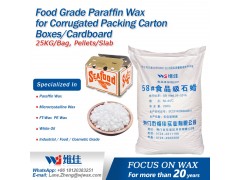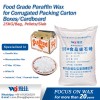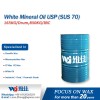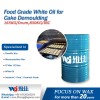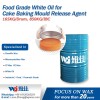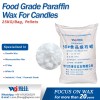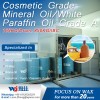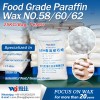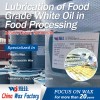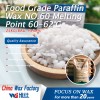Food grade paraffin wax is commonly used in the production of corrugated packing carton boxes or cardboard. Such as custom waxed cardboard, wax-coated corrugated paper boxes, fruit packaging boxes, vegetable packaging boxes, fresh food packaging, etc.
It serves multiple purposes in Vegetable and fresh fruit packaging boxes/Wax Corrugated Carton box:
Moisture Resistance: Paraffin wax acts as a moisture barrier, preventing the absorption of moisture by the packaging boxes. This helps maintain the structural integrity and strength of the packaging, ensuring the protection of the contents from moisture-related damage.
Surface Coating: Applying a thin layer of wax to the surface of cardboard provides a smooth and glossy finish. This coating enhances the visual appeal of the packaging and improves its overall quality.
Varnish Substitute: It can serve as a substitute for traditional varnishes used on carton boxes. It provides a protective layer that enhances the durability and resistance of the packaging to scuffs, scratches, and general wear.
Heat Sealability: It can be used as a heat sealant on certain types of corrugated packing carton boxes. By applying heat, the wax can be melted and used to seal the boxes, ensuring secure closure and tamper-evident packaging.
FDA Compliance: It is specifically formulated to meet the safety standards set by the Food and Drug Administration (FDA). This ensures that the wax used in food packaging is safe for direct contact with food products.
Overall, food grade paraffin wax plays a crucial role in the manufacturing of corrugated packing carton boxes or cardboard by providing moisture resistance, surface coating, varnish substitute, heat sealability, and compliance with food safety regulations.
The COA of Food grade paraffin wax 58#:
Executive Standard: GB 1886.26-2016
Product Batch Number: 20230419
|
Analysis Items |
Quality Index |
Detection Result |
Test Method |
|
|
Melting point/℃ |
58-60 |
58.9 |
GB/T2539 |
|
|
Oil content w% |
≤0.5 |
0.40 |
GB/T3554 |
|
|
Color/Saybolt No. |
≥28 |
+28 |
GB/T3555 |
|
|
Light stability /No. |
≤4 |
3.2 |
SH/T0404 |
|
|
Penetration(25℃,1/10mm) |
≤18 |
17.20 |
GB/T4985 |
|
|
Viscosity(100℃)(mm²/s) |
Report |
4.118 |
GB/T265 |
|
|
Odor/No. |
≤0 |
0 |
SH/T0414 |
|
|
Mechanical impurity and moisture |
None |
None |
Visualization |
|
|
Water-soluble acid or alkali |
None |
None |
SH/T0407 |
|
|
Carbonizable substances |
Pass |
Pass |
GB/T7364 |
|
|
Condensed aromatics,ultraviolet absorbance/cm |
280nm-289nm ,not more than |
0.15 |
0.13 |
GB/T7363 |
|
290nm-299nm,not more than |
0.12 |
0.09 |
||
|
300nm-359nm ,not more than |
0.08 |
0.07 |
||
|
360nm-400nm,not more than |
0.02 |
0.01 |
||
FAQ:
Q1: What are the main advantages of using food grade paraffin wax in packaging?
A1: It offers several advantages in packaging applications. Firstly, it acts as a moisture barrier, protecting the packaged goods from moisture damage. Secondly, it provides a smooth and glossy finish, enhancing the visual appeal of the packaging. Lastly, it is safe for direct contact with food, ensuring compliance with food safety regulations.
Q2: What types of packaging applications commonly utilize edible paraffin?
A2: It finds application in various packaging formats. It is commonly used in coating materials for paper and cardboard packaging, such as corrugated boxes, cartons, and food containers. Additionally, edible paraffin wax is utilized in coatings for flexible packaging materials like wraps, pouches, and bags. Its moisture resistance and protective properties make it suitable for a wide range of food packaging applications.


